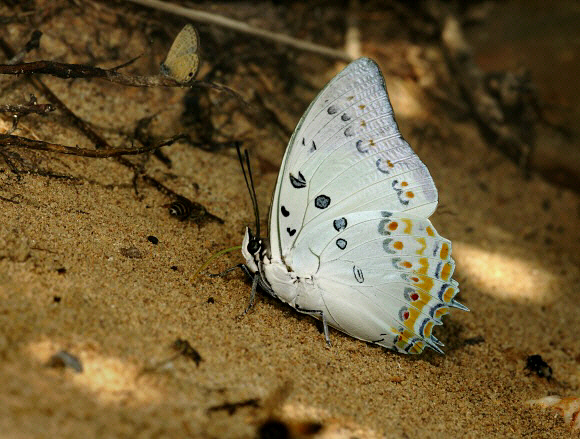
Introduction
There are 24 species in the genus Polyura, most of which are found in the Oriental region, although one species posidonius is restricted to Tibet and west China; 6 or 7 are endemic to various islands, e.g. andrewsi from Christmas Island and caphontis from Fiji; and one, pyrrhus reaches Queensland in Australia. 7 species occur in Malaysia – athamas, delphis, eudamippus, hebe, jalysus, moori and schreiber.
The butterflies are characterised by their distinctive wing shape with twin tails on the hindwings, a feature strongly reminiscent of the African Charaxes. Most have dark brown uppersides with bands of dazzling creamy white which vary in size and shape from one species to another. These bands are usually repeated on the underside in a beautiful shade of pale green, but in the case of delphis the underside is white, and marked with orange, yellow and grey spots and lunules, hence its alternative name the Jewelled Nawab.
Polyura delphis is one of the scarcer species, and is found in Assam, Sikkim, Myanmar, Thailand, peninsular Malaysia, Sumatra, Sabah, Brunei, Kalimantan, Palawan and Java.
Habitats
This species is found in primary rainforest at altitudes between about 100-600 metres.
Lifecycle
I have no data regarding delphis, but the lifecycle is likely to be similar to that of other Polyura species. The eggs will be spherical, probably yellow in colour, and laid singly on the underside of leaves of the foodplants. The caterpillar when fully grown will be green, and probably marked with one or more pale dorsal bands. As with other Polyura species it will have a large head with a flat face, adorned with a crown of 4 impressive long horns. The foodplants are likely to be primarily members of the Fabaceae. The chrysalis will be green, probably streaked or marbled with white, and will have a plump, rounded and compressed abdomen. It will be attached by the cremaster to a twig or stem on or near the foodplant.
Adult behaviour
Males visit damp sand along river beaches, but do not normally aggregate with other species. The individual depicted above was one of a pair of delphis males which were attracted to urine-tainted sand on a tributary of the Sungai Tembeling in Taman Negara national park.
